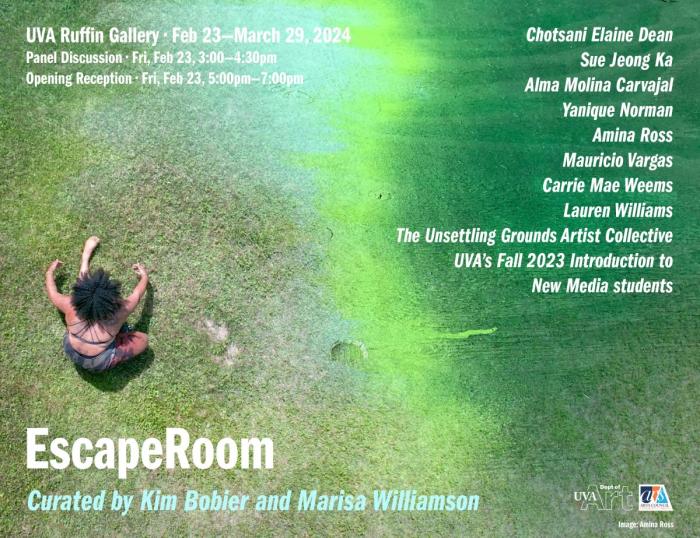EscapeRoom

Curated by Kim Bobier and Marisa Williamson
February 23 - March 29, 2024
Panel Discussion: Friday, February 23, 3 - 4:30 pm
Opening Reception: Friday, February 23, 5 - 7 pm
WTJU Interview with Marisa Williamson about the EscapeRoom Exhibition in Ruffin Gallery.
University of Virginia (UVA) is a site of reckoning. The legacies of slavery and white supremacy reverberate throughout its built environment. EscapeRoom confronts frameworks of injustice that contemporary audiences inhabit and inherit in relation to this UNESCO World Heritage Site. Its title evokes “edutainment” formats, such as museum period rooms and escape room games, which immerse visitors in scenes of the past. Yet, rather than reproducing one historical container or master narrative, EscapeRoom charts critical routes through a maze of predatory systems. It showcases recent works by artists who operate across temporalities, geographies, and disciplines to hack the master’s tools and harness radical alternatives.
Thomas Jefferson, founding father of both UVA and the USA, designed a plantation-university. His paradoxical vision of freedom still permeates the school and the nation. Perhaps this is why Angela Davis called the palatial campus’s lawn rooms “cramped as prison cells.” Suppose you are trapped in a system that defines you not as you are. How do you get through, get out, or transform? EscapeRoom’s artworks explore carceral, colonial technologies of (over)sight. The artists’ perspectives offer counterprogramming to UVA’s founding pedagogy of paternalism and racializing surveillance, typified by Jefferson’s Anatomical Theatre, a now-demolished UVA classroom that advanced a race science of biological hierarchy. Students, faculty, and professional grave-robbers plundered Black burial grounds to obtain cadavers for anatomical dissection and observation. Such dehumanizing dynamics in the name of science laid a foundation for UVA to become an epicenter of early twentieth-century eugenics.
On Grounds (as the UVA campus is known), the academic art gallery promotes a different kind of dissection and observation. How can this space serve as a site of autopsy (from the Greek, to “see for oneself”)? How can it forge sightlines of redress and amplify the personhood of people (past and present) who are treated as fungible objects of supervision? The Anatomical Theatre is the only Jefferson-designed building that the university has torn down. Yet, “[t]he master’s tools will never dismantle the master’s house,” cautions Audre Lorde. At the very least, EscapeRoom’s artworks unsettle its foundation from within. The artists, most of whom identify as women and femmes of color, work in an array of media, from ceramics, installation, textile to Augmented Reality. They variously sneak in protective heirlooms, summon guidance from ghosts, track the elusive war machine, reclaim prison-censored material, reimagine race and gender as technology, and activate interdisciplinary hush harbors. These interventions trace lines of flight while questioning the viability of escape. Leery of simple solutions, the exhibition gathers multisensory and multi-dimensionally expressive forms of sense-making. It convenes clues as to how, if at all, we might get free.
CURATORS
Marisa Williamson, Assistant Professor of Studio Art at University of Virginia with a research focus on Blackness and Kim Bobier, Adjunct Assistant Professor at Pratt Institute’s Department of History of Art and Design
ARTISTS
Chotsani Elaine Dean | Sue Jeong Ka | Alma Molina Carvajal | Yanique Norman | Amina Ross | Mauricio Vargas | Carrie Mae Weems | Lauren Williams | The Unsettling Grounds Artist Collective | UVA’s Fall 2023 Introduction to New Media students
Supported by the UVA Arts Council and the UVA Department of Art